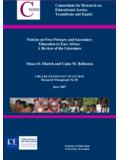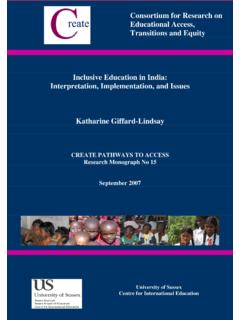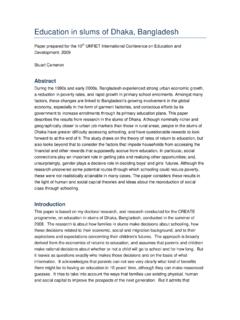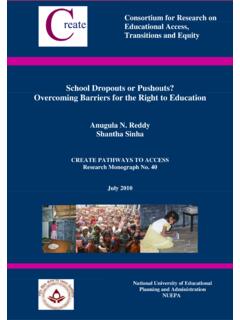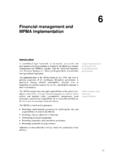Transcription of ‘NO FEE’ SCHOOLS IN SOUTH AFRICA
1 Consortium for Research on Educational Access, Transitions and Equity (CREATE) : 00 44 NOFEE SCHOOLS INSOUTH AFRICAPOLICY BRIEFN umber7 August2009 NOFEE SCHOOLS IN SOUTH AFRICA40% of SCHOOLS in SOUTH AFRICA , namely the poorest two-fifths as determinedby poverty indicators,were declared to be no fee schoolsas of 2007. These SCHOOLS receive largerstate allocations perlearnerthan other SCHOOLS , as well as a higherallocation for non-personnel, other SCHOOLS parents may continue to apply for fee exemptions.
2 The implicationsand extent of these efforts to promoteequity and redressin education continue to generate muchdebate, among which are concerns that, whileschool feesmaynotkeep children out of school,they do helptosustain a class-differentiatedtwo tiereducation to SOUTH AFRICA stransition fromapartheidtodemocracy has beenthe establishment of aquality, in social spendinghas been considerably reduced since 1994,spending inequalities remain because of the highcosts required to achieve fiscal parity in the immediate post-apartheid period, a majoremphasis was on distributing resource inputsthrough policy and legislation based on equity andredress, but by 1999 thestate of theeducationsystem could still be characterized bytheDepartment of Educationasone of rampantinequality.
3 Under particular scrutiny was whetherthe gap between rich and poor SCHOOLS in thepublicschooling system was closing or, in fact,increasing. In particular a key policy change whichhas engendered much debate is about thepresence of user feesin the public schoolingsystem, or what can bereferred to as theprivatisation of public policy brief provides a broad overview ofpolicy changes inSouth Africaneducationwith aparticular focus oneducation financingand therecent introduction of the no fee with some critical observations aboutthe success of this policy and its SOUTH African policy context.
4 The searchfor equity in educationPost-apartheid education transformation has beenimpressive in scope, coverage and governmentembarked onsystematicallydismantlingthe previous segregated educationracial order as well asoncomprehensively revisingthe entire education policy environment at all levelsof the education system. The full scale of thechange, described bythe2008 UNESCOG lobalMonitoring Reportasambitious,isindicated by thewaythe government has: Revised the entire curriculumframework from asubject-based orientation to an outcomes-basedone; Integrated education and training through theNational QualificationsFrameworkwhich placesallformsof learningona single qualifications ladderwith equivalent forms of certification.
5 No fee SCHOOLS in SOUTH AfricaConsortium for Research on Educational Access, Transitions and Equity (CREATE) : 00 44 Transformedthe higher education landscape bymerging and closing down institutions; Integrated all teacher educationinstitutions intouniversities; Changed the governance of SCHOOLS , includingprivateschoolswhich,subject to certain conditions,areeligible for a state subsidy; Created avalues-in-education programme; Committed itself to an inclusive educationprogrammewhichadoptsamainstream ingapproach to special education ; and Extended Early Childhood Care and Educationby creatinganadditional pre-primary (Grade 0)year,with full coverage envisaged by to the policy changes is the SOUTH AfricanSchools Act (SASA)of 1996which createddemocratically elected school governing bodies(SGBs) at all public SCHOOLS .
6 SGBresponsibilitiesincludetaking all reasonable measures within itsmeans to supplement the resources supplied to theschool in order to improve the quality of educationprovidedfor all learners at the school (SASA,Section 21).In practice this has generally meantintroducing school a fee is approvedbythe SGB, all parents are required to pay, exceptthose who applyforand are granted an exemptionbased on incomeand verified through meanstesting. Learners cannot be denied admissionbecause of their parents failure to pay fees,although SGBs can sue parents for other developing countries,risingenrolment and participationratesin SOUTH Africamakeit difficult to argue that school fees keepchildren out of ,fees have affectedthe pattern of enrolment.
7 In thatfees constitute asocial classbenchmarkby whichparentssortthemselves in terms of theirwillingness to payandtheirselection of SOUTH Africanpublicschooling systemthus remainscharacterised by avast number of distinctly disadvantaged schoolsand a small pocket of highly privileged SCHOOLS . No fee SCHOOLS in SOUTH AFRICA :The SchoolFunding Norms andrecentamendmentsBecause of wide disparities in fiscal capacityamongstSouth AFRICA s nine provinces, there is anunequal gap between the amount of tax revenueeach province can raiseand theamount of moneyit needs to fulfil its responsibilities for basicservices,including this,aportion of nationally raised revenues is distributedto provinces and local governmentsthrough theEquitable Share Formula,based on demographicand social criteria.
8 Another mechanismaimed atimproving equity in education financingistheNationalNormsandStandards, whichrequire thatprovincial departments rankeach schoolintooneoffive quintiles,with Quintile 1 beingthe poorestandQuintile5 the least poor, based on rates ofincome, unemployment and illiteracywithin theschoolcatchment 2006 Education LawAmendment Act replacedthe provincial quintileswithnational ones. While there were many gainsinterms of increasing equality,there was a clearrecognition both within andoutside the state thatatwo tier education systemwas operatingin SouthAfrica, one catering for the wealthy (whichremainedlargelywhite)and one catering for thepoor(which remained black).
9 In response,the2006 NationalNormsandStandardsdeclaredschools in quintiles 1 and 2to beno fee SCHOOLS ,compensating these schoolswithahigherallocationfornon-perso nnel, Amended National Norms and Standards forSchool Funding(ANNSSF), which came into effecton 1 January 2007, specifically withpublic funding ofbothpublicandindependent (private) SCHOOLS ,aswell as withschool fee exemptions to public SCHOOLS is provided in two forms:personnelexpenditureandnon-personn elexpenditure(otherwisereferred to as the schoolallocation).
10 Personnelexpenditureremainedunchanged, but theratio of personnel to non-personnel expenditurewas set at 80:20 (DoE,2006).The school allocation is developed using fiveconsiderations:the rights of learners, the minimumbasic package to ensure quality education, pricesof goods and services,thenational distribution ofincome differencesand poverty, andlastlythestate budget. Themajority of items covered by theschoolallocationfall into what can be termedrunningcosts(stationery,maintenanc eandservicessuch aselectricity).

